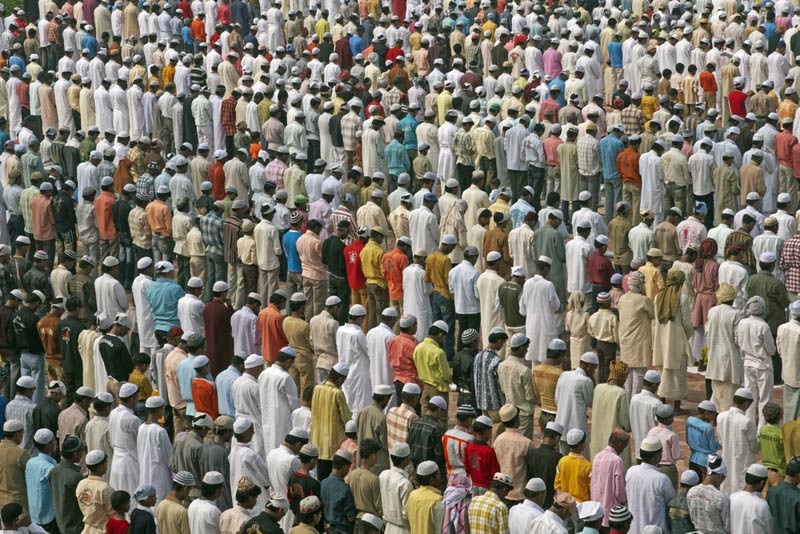Crowded Planet: 7 (Billion) Population Milestones
7 Billion People?

On or around Oct. 31, 2011, the world's 7 billionth person will be born, the United Nation estimates.
Even more staggering is that of the 7 billion people on Earth, about 1.4 billion of them will be old enough to have observed the arrivals of the 6 billionth, 5 billionth, 4 billionth and 3 billionth people in the world. About 42.5 million people could have blown the party horn for the birth of the 2 billionth baby.
Yes, population has risen very quickly over the last century. Demographers do expect a decline in the population growth rate, but absolute numbers will continue to rise, likely hitting 9 billion by 2050. Meanwhile, we look back at history's past population milestones, asking: "How has the world changed?"
1805 – The 1 billionth baby

The world's first billion-person milestone was a long time coming. Estimates of historical populations can be rough, but the U.S. Census Bureau pegs the global population at a paltry 5 million people in 8000 B.C. Certainly, humans remained scarce until the development of agriculture some 10,000 years ago. Even after our kind began farming, it was a slow climb to the 100-million-person mark around 500 B.C.
From there, population growth gets a bit more exciting. Somewhere around A.D. 500 to 600, humans hit the 200-million mark. By about 1250, the population had doubled to between 400 million and 416 million. Plagues and wars took a toll on the global human population before the 1400s, but the numbers then started a steady tick upward. [Infographic: Urban Population Explosion]
The birth year of the world's billionth baby will never be certain, but it's likely he or she came into the world around 1805. Beethoven was big that year, and already going deaf. Lewis and Clark made it to the Pacific Ocean. Napoleon was on a roll in Europe, 10 years from his defeat in the Battle of Waterloo. With the exception of a few coastal outposts, most of Africa was a complete mystery to Europeans. In China, the Qing Dynasty had just put down the White Lotus Rebellion, a tax protest that ultimately killed about 16 million people — a reminder that mass death and population growth don't necessarily cancel one another out.
1927 – Race to 2 Billion

It had taken thousands of years for the population to reach 1 billion, but 2 billion was barely more than a century away. The 2 billionth baby was likely born in the late 1920s, perhaps 1927; the U.N. estimates that by 1930 there were 2.07 billion people on the planet.
Get the world’s most fascinating discoveries delivered straight to your inbox.
This sudden takeoff of population makes sense in the context of a phenomenon called the demographic transition. In the transition, a population goes from one with high birth rates and high death rates (imagine farming families having seven or eight kids in hopes of a few reaching adulthood) to one with low birth rates and low death rates (where parents usually have one or two kids and expect them to grow up).
In the midst of this transition is a period when death rates are declining but people have yet to alter their behavior: They still have lots of kids. Even if those kids decide to have only a few children of their own, population will remain high, because there are so many potential parents.
The agricultural and industrial revolutions led to gradually declining death rates in the Western world starting in the 1700s, while birth rates remained fairly high for generations. As developed countries began to see falling birth rates, developing countries entered the transition period of declining death rates and high birth rates. Some countries in sub-Saharan Africa are just entering the demographic transition today.
But back to 1927. If the 2 billionth baby was indeed born in this year, he or she came into being the same year that the first trans-Atlantic telephone call was made (from New York City to London). The world was on the cusp of the Great Depression. Mao Zedong battled the Kuomintang in Hunan, China, and lost — for a time. An enormous flood along the Mississippi River inundated 27,000 square miles (70,000 square kilometers), the greatest natural disaster in U.S. history at that point (photo shown above in Illinois on March 25, 1927).
1959 - 3 Billion People

The 3 billionth baby was a Cold War baby, born in approximately 1959. If he or she was a westerner, baby No. 3 billion would have been a baby boomer, part of the generation born after World War II. During this period, births in the U.S. rose from around 2.8 million a year in the 1930s and early 1940s to a peak of about 4.3 million births per year in the late 1950s.
Worldwide, the population growth rate hit a peak of more than 2 percent per year in the early 1960s, just after our 3 billionth baby's birth. The growth rate had been increasing since 1950, according to the U.S. Census Bureau, with one rapid downward plunge between 1959 and 1960. This hiccup was because of China's Great Leap Forward, a disastrous industrialization and collectivization push that killed millions and caused China's fertility rates to plummet. (Shown above: a Communist monument on Tiananmen Square in Beijing, China.)
The year the 3 billionth person was born was also the first year that rocket scientists were able to send monkeys to space and bring them back alive. The Dalai Lama fled Tibet during an uprising and set up a government-in-exile in India. And in a fitting tie to humanity's evolutionary roots, Louis and Mary Leakey discovered the first skull of the ancient hominid Australopithecus.
1974 - A Billion More

Only 15 years after humanity reached the 3 billion mark, it was time to ring in the 4 billionth. It all seemed rather sudden, and people were noticing. In 1968, biologist Paul Ehrlich and his wife, Anne, published "The Population Bomb" (Sierra Club/Ballentine Books), sounding a doleful alarm about overpopulation and predicting mass famine in the 1970s.
Those predictions didn't come to pass, though the book did catapult serious issues of overconsumption and resource scarcity into the limelight. In 2009, the Ehrlichs wrote in the Electronic Journal of Sustainable Development that many of their dire concerns persisted, including fishery collapse, major extinctions and fears of an epidemic. The researchers admitted they had underestimated agricultural advances in feeding a hungry world, but argued that they were partially right: Between 1968 and 2009, they wrote, "perhaps 300 million people overall have died of hunger and hunger-related diseases." [7 Devastating Infectious Diseases]
So baby No. 4 billion was not entering the world at an optimistic time, population-wise. But the world had changed in many ways in the 15 years since baby No. 3 billion took his or her first breath. Forget space monkeys: The human crew of Skylab 4 (shown above) returned to Earth alive and well after 84 days in orbit. Second-wave feminism had hit a stride in the U.S., ushering in a number of legal victories aimed at workplace and educational equality for women. And just as the first Australopithecus skull was found the year the world's population rose to 3 billion, "Lucy," the famed 40-percent-complete Australopithecus afarensis skeleton, was found in 1974, the year the population hit 4 billion.
1987 - The Day of 5 Billion

On July 11, 1987, the United Nations marked "The Day of 5 Billion," the organization's best estimate of when the 5 billionth human might be born. The event was such a hit that July 11 is now "World Population Day" every year.
Which isn't to say the Day of 5 Billion was a celebration, exactly. The then-president of the Population Institute in Washington, D.C., told the New York Times in 1986 that the 5 billionth baby was "a sobering symbol of the shocking rapidity at which the world's population is multiplying." (In a sign of how difficult exact population counts are, the Population Institute pegged the 5-billion milestone to July 1986 instead of 1987.)
But people in the 1980s were no longer as panicked over population as they had been in the 1970s. A 1986 National Academy of Sciences report argued that the time of peak population growth was past; birth rates in developing countries were down sharply, as was fertility in the developing world, though population was still expected to climb. The Carter administration had been concerned about overpopulation, the New York Times reported in 1986, while President Ronald Reagan's advisers argued that market forces and scientific progress would solve any problems caused by population growth.
In fact, it had taken about 13 years to add another billion people to the planet, and it would take 12 the next time around. In the meantime, Baby 5 Billion actually got a name: Matej Gaspar, a 7-pound, 9-ounce Croatian boy, was declared by the United Nations to be the official 5 billionth person on the planet. Matej was born at 8:35 a.m. local time in the city of Zagreb, according to Associated Press reports from the time. The secret of being the 5 billionth baby was location, location, location: Officials looked to Zagreb for the birth because the 14th World University Games were being played there at the time. (Photo shows a crowded street in Croatia.)
1999 - Milestone 6 Billion

Baby No. 6 billion got an official designation, too: Adnan Nevic, born in Sarajevo, Bosnia, on Oct. 12, 1999. Adnan got his label seemingly because then-U.N. Secretary-General Kofi Annan happened to be in town for a photo shoot.
In less than 75 years, the global population had tripled. The global death rate in 1999 was half what it was in 1950, the U.N. reported, while the average global life expectancy had increased by 20 years over the same period, from 46 to 66.
Fertility was down worldwide by 1999, though the number of children per mother varied widely by country. In Europe, 1.4 babies were born per woman on average, below replacement level. Meanwhile, in sub-Saharan Africa, the average figure per woman was 5.5 babies. There, the fertility rate had dropped by only one child since 1950.
Notably, Adnan Nevic (or whoever Baby 6 Billion really was) was born into a world with more young people than ever before. Over 1 billion people were between ages 15 and 24 in 1999, all entering peak childbearing years themselves.
2011 - A World of 7 Billion

Who will Baby 7 Billion be? While the United Nations places his or her birthday at around Oct. 31, 2011, the U.S. Census Bureau, going with slightly more conservative numbers, estimates a February 2012 due date.
Where the 7 billionth baby will be born is impossible to know. But Plan International, an international child advocacy agency, is taking a bet on Uttar Pradesh (shown in photo during a Muslim ceremony), India's most populous state. The group plans to present a birth certificate to a baby girl in the region on Oct. 31 to draw attention to the problem of sex-selective abortions in India.
Birth rates have been declining in Utter Pradesh since the 1970s, but not as much as the rest of India, making the area a likely spot for the 7 billionth baby. According to the Indian Ministry of Health and Family Welfare, Uttar Pradesh had a fertility rate of 3.8 births per woman in 2008, compared with 2.6 births per woman in India as a whole.
What's next for a growing world? The U.N. estimates that baby No. 8 Billion will take its first breath around 2025. According to the organization's 2010 population report, Baby 9 Billion will show up shortly before 2050, and the world will welcome its 10 billionth person by 2100. Most of the growth will be in high-fertility countries such as those in sub-Saharan Africa: The population in these areas is likely to triple. Meanwhile, intermediate-fertility countries such as the U.S., Mexico and India will grow by 26 percent, and low-fertility regions such as Europe will actually shrink by 20 percent.

Stephanie Pappas is a contributing writer for Live Science, covering topics ranging from geoscience to archaeology to the human brain and behavior. She was previously a senior writer for Live Science but is now a freelancer based in Denver, Colorado, and regularly contributes to Scientific American and The Monitor, the monthly magazine of the American Psychological Association. Stephanie received a bachelor's degree in psychology from the University of South Carolina and a graduate certificate in science communication from the University of California, Santa Cruz.


